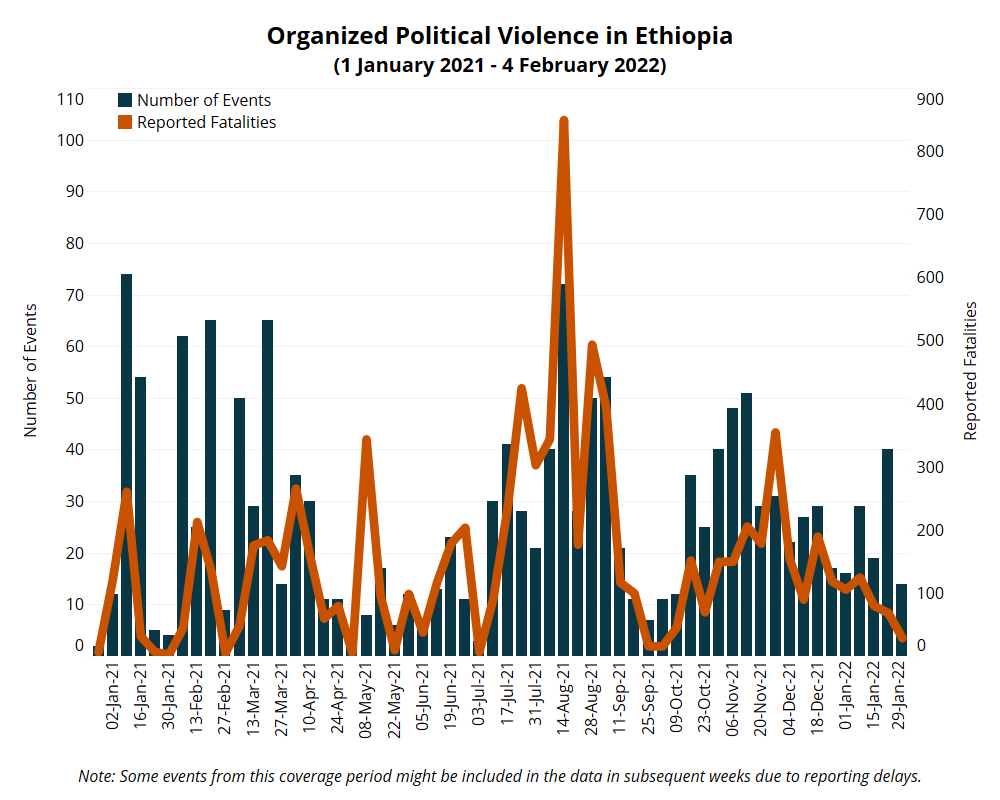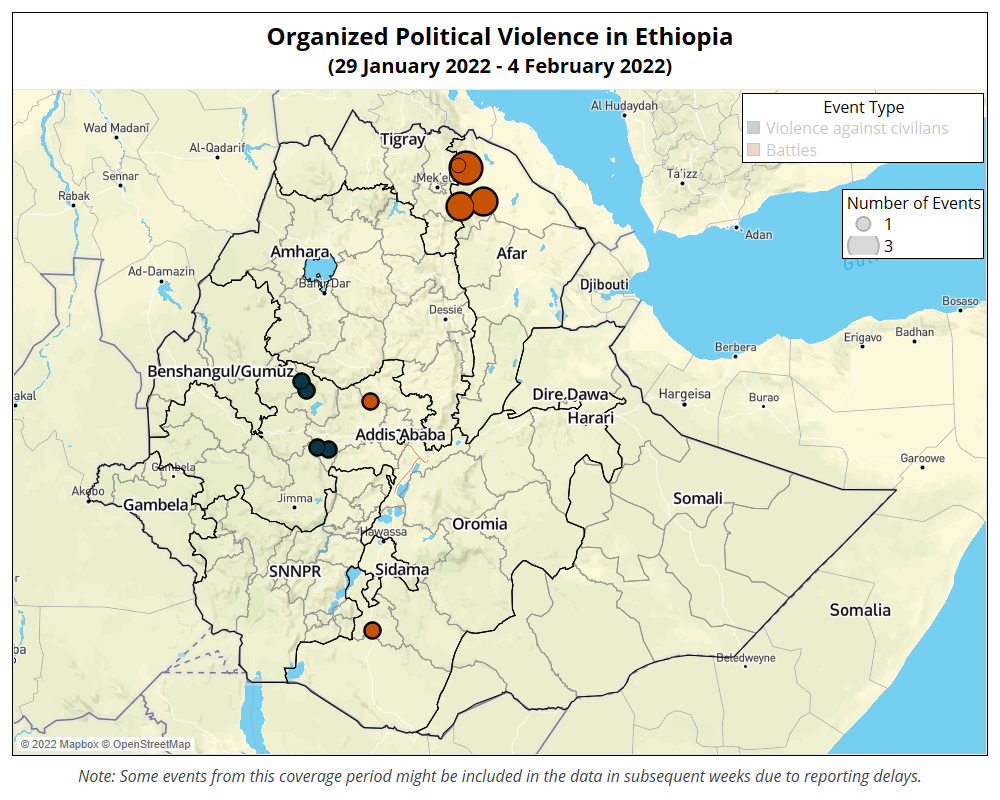By the Numbers: Ethiopia, 2 April 2018 – 4 February 2022 1Figures reflect violent events reported since Prime Minister Abiy Ahmed came to power on 2 April 2018.
- Total number of organized violence events: 2,540
- Total number of reported fatalities from organized violence: 14,389
- Total number of reported fatalities from civilian targeting: 6,530
By the Numbers: Ethiopia, 29 January – 4 February 2022 2Some events from this coverage period might be included in the data in subsequent weeks due to reporting delays.
- Total number of organized violence events: 14
- Total number of reported fatalities from organized violence: 29
- Total number of reported fatalities from civilian targeting: 26
Ethiopia data are available through a curated EPO data file as well as the main ACLED export tool.

Situation Summary
Clashes continued throughout the past week in the Afar region as the Tigray People’s Liberation Front (TPLF) forces fought against Afar regional special forces and local militias in Abala town on the Tigray/Afar regional border. Clashes spread to Berhale, Magala, Kunneba, and Erebti areas of Kilbati Rasu-Zone 2 as TPLF forces moved toward the east (see map below). Residents of these areas reported heavy fighting between the warring parties, using heavy artillery and small arms (DW Amharic, 31 January 2022).

Last week, residents in Hayu town in Eliadar woreda and Semera Logiya in the Afar region protested against TPLF attacks in Kilbati Rasu-Zone 2 (Amhara Media Corporation, 30 January 2022; ESAT, 31 January 2022). In addition, a group of Afar diaspora held a demonstration denouncing the TPLF attacks in Kilbati Rasu-Zone 2 in front of the European Commission headquarters in Brussels, Belgium (DW Amharic, 2 February 2022). The protesters also condemned the federal government’s silence regarding the armed clashes in the zone.
In the Oromia region, fighting between Oromia special forces and Oromo Liberation Front (OLF)-Shane militants intensified in the West Guji zone, with OLF-Shane forces taking control of several locations including Torre, Shamole, and Kersa localities in Gelana woreda (VOA Amharic, 5 February 2022).
In the East Wollega zone, federal forces conducted a number of operations against OLF-Shane and “other armed groups” operating in the zone. According to local officials, 22 kebeles in Nunu Kumba woreda in the East Wollega zone were controlled by OLF-Shane militants, 14 of which were re-taken in a joint operation by Ethiopia National Defense Force (ENDF) soldiers, Oromia regional special police, and Oromia state police (EBC, 8 February 2022). Government security forces also claimed a second operation in Gidami woreda in the Kellem Wollega zone, taking control of the area after clashing with OLF-Shane forces (EBC, 7 February 2022). Last week, Oromia regional special forces also clashed with OLF-Shane forces in Anfilo woreda in Kellem Wollega zone, capturing 17 fighters.
Furthermore, clashes continued in the Oromia region between Amhara militias and local Oromo militias, resulting in the displacement of civilians and the destruction of property. In Dano woreda, Amhara militiamen reportedly attacked Oromo farmers in Ajilo Dalle kebele, killing eight civilians. Additional clashes and instances of violence against civilians involving Amhara militias in the Oromia region were reported in the Jarte Jardega and Amuru areas of the Horo Gudru Wollega zone.
In the Gambela region, regional officials, including the regional president, traveled to Juba, South Sudan on 2 February 2022 to discuss issues related to cross-border attacks on residents in the region by Murle militias (VOA Amharic, 2 February 2022). Attacks earlier in the month led to at least eight fatalities, as well as kidnappings and cattle rustling (DW Amharic, 21 January 2022).
In Benshangul/Gumuz region, UN and humanitarian partners are scrambling to support newly displaced populations. Estimates indicate that 20,000 people were displaced following clashes between an unidentified armed group and federal forces near Togo town on 18 January 2022 (UNHCR, 4 February 2022).
Weekly Focus: Humanitarian Crisis in Ethiopia
Ongoing hostilities in northern Ethiopia, the Oromia region, as well as drought throughout the South/East of the country have displaced thousands and are stretching government resources. In the Tigray region, TPLF authorities have been unable to provide basic services for months, and huge swaths of the population are at risk.
According to the Afar regional authorities, more than 300,000 people are internally displaced due to recently renewed armed clashes between TPLF and the Afar regional special forces and militias in Kilbati Rasu-Zone 2 in the Afar region (DW Amharic, 7 February 2022; DW Amharic, 31 February 2022;). Renewed conflict on the Semera-Abala route in Abala town and Southern Tigray has rendered the delivery of aid by trucks impossible, and no humanitarian assistance has been delivered since 15 December 2021 (UNOCHA, 3 February 2022; VOA Amharic, 24 January 2022). Humanitarian convoys used to travel through the Semera-Abala main road to deliver humanitarian supplies to the Tigray region. As mentioned, since violence has escalated in Kilbati Rasu-Zone 2 since 24 January 2022, humanitarian convoys are unable to travel through the Semera-Abala route. Nevertheless, between 26 January and 4 February, the International Committee of the Red Cross (ICRC) organized several humanitarian flights and delivered “vital medical supplies” like “insulin, hemodialysis, oxytocin, tetanus toxoid, gloves, and surgical material” to the Tigray region (ICRC, 4 February 2022; ICRC, 26 January 2022).
In addition to the clashes in the Afar region, members of the Raya ethnic group residing in Waja, Temuga, and Alamata areas in the Southern Tigray zone have been internally displaced due to recent TPLF forces attacks in these areas. These internally displaced people (IDPs) are asking for humanitarian assistance (Amhara Media Corporation, 24 January 2022). Most of these IDPs are located in Kobo in the North Wello zone in the Amhara region. According to the administrator of Waja and Tumuga kebele, more than 12,000 people have recently taken refuge in Kobo town (VOA Amharic, 27 January 2022). Even though many IDPs, who were displaced during the earlier phase of the conflict in the Amhara region, have returned to their homes, the need for humanitarian assistance is high due to the destruction of livelihoods, infrastructure, and farmland (DW Amharic, 1 February 2022).
In the Oromia region, thousands of civilians are internally displaced due to OLF-Shane attacks and armed clashes between OLF-Shane and government forces. These attacks against civilians and armed clashes were recorded in West Shewa, West Wollega, East Wollega, Horo Guduru, and Guji zones in the Oromia region. IDPs from these areas are dispersed across Oromia, Benshangul/Gumuz, and Amhara regions (VOA Amharic, 4 January 2022; Amhara Media Corporation, 24 January 2022). As attacks against civilians and armed clashes continue, the number of IDPs is expected to increase in the Oromia region.
Furthermore, 6.8 million people living in Oromia (eight zones), Southern Nations, Nationalities and Peoples (seven zones), Southwest Ethiopia (one zone), and Somali (ten zones) regions are affected by a prolonged drought due to three consecutive failed rainy seasons (UNOCHA, 7 February 2022). Last week, Prime Minister Abiy Ahmed visited drought-affected areas in the Borena zone in the Oromia region (Facebook, Abiy Ahmed Ali, 3 February 2022). A week earlier, Abiy visited other drought-affected areas in the Somali region (Facebook, Abiy Ahmed Ali, 25 January 2022). Different national institutions like private banks, companies, and regional governments are donating money and different supplies to Oromia and Somali regional governments to tackle the impact of drought in these regions.
These crises are stretching the government’s resources and its ability to assist the populations affected by conflict and drought. Both national and international stakeholders are making huge efforts to provide humanitarian assistance to these populations. However, gaps in resources have left many in the country impoverished. Armed conflict throughout the country has led to the disruption of thousands of lives and placed hundreds of thousands in need, a trend that is expected to continue as clashes are ongoing.






